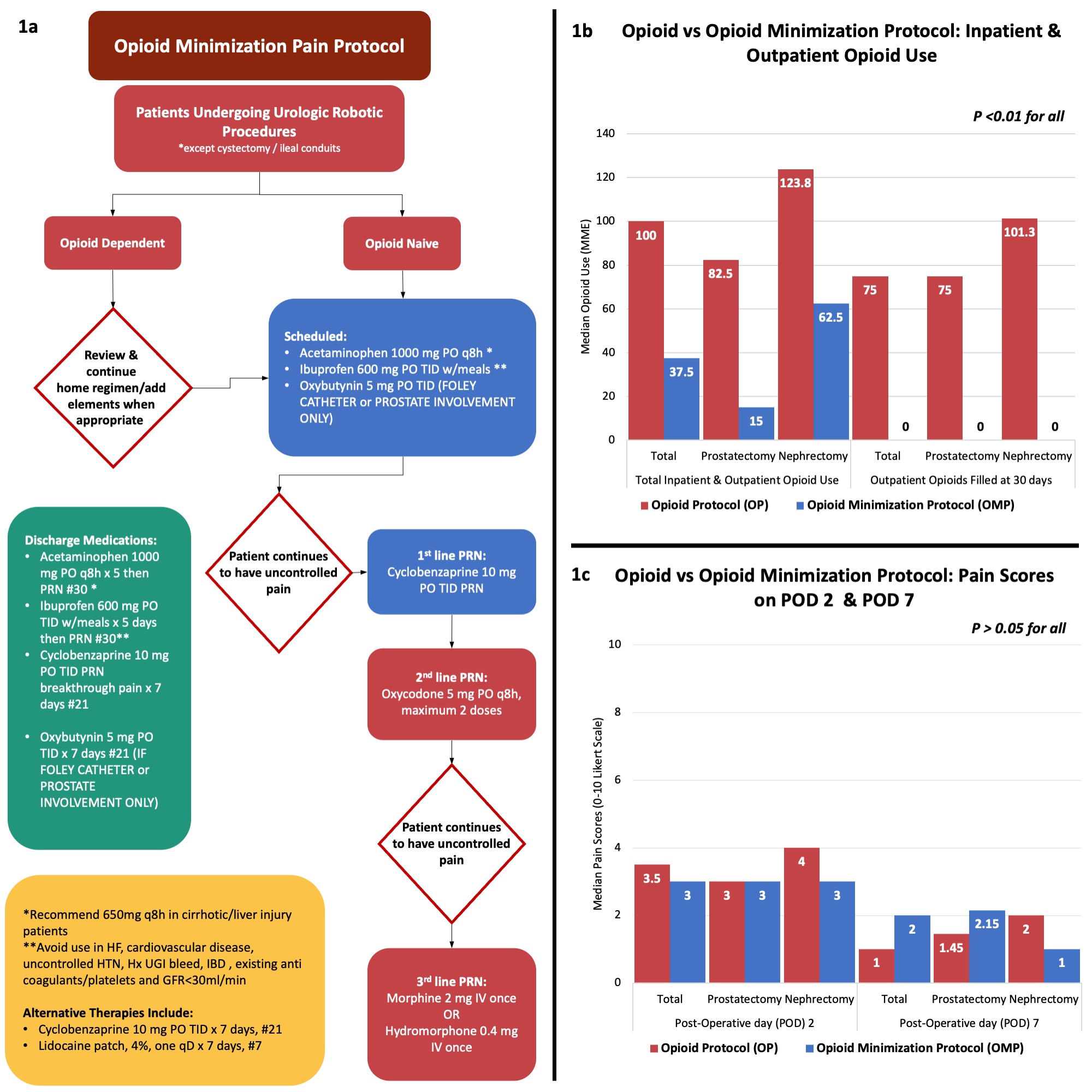Back
Poster, Podium & Video Sessions
Moderated Poster
MP31: Health Services Research: Quality Improvement & Patient Safety II
MP31-02: Decreased Opioid Use & Equivalent Pain Score Outcomes After Urologic Robotic Surgery Using A Simplified Opioid Minimization Protocol: A Prospective, Non-inferiority Study
Saturday, May 14, 2022
2:45 PM – 4:00 PM
Location: Room 228
Sofia Gereta*, Safiya-Hana Belbina, Elizabeth Blankenship, J. Stuart Wolf Jr., E. Charles Osterberg, Aaron A. Laviana, Austin, TX
- SG
Sofia Gereta, BA
Dell Medical School UT Austin
Poster Presenter(s)
Introduction: The United States opioid epidemic has called attention to opioid overprescription after surgery. We conducted a prospective, non-inferiority study introducing a simplified, opioid-minimization protocol to decrease opioid consumption for opioid-naïve patients after urologic robotic surgery without worsening patient pain or satisfaction.
Methods: Patients undergoing urologic robotic surgery were prospectively followed from Jan-Oct 2021, with the opioid minimization protocol (OMP) implemented in June 2021 (Figure 1a). In the baseline opioid protocol (OP), patients received opioids and gabapentin as needed for severe pain without standardizing non-opioids in the regimen. On postoperative days two (POD 2) and seven (POD 7) patients answered a validated outcomes questionnaire, the Brief Pain Inventory, and a satisfaction survey via phone call. Pain severity, pain interference with activities, and satisfaction were rated on a 0-10 scale. Retrospectively, opioid dispensation records from the Texas Prescription Monitoring Program (PMP) were collected and chart reviews were performed. Opioid usage was calculated in morphine milligram equivalents (MME). Comparison between protocols, including analysis by case type, was done using the chi-square test or Fisher’s exact test for categorical variables and the Wilcoxon Mann–Whitney U test for continuous variables.
Results: 79 consecutive opioid-naïve patients were included, with a 96.2% questionnaire response rate (OP: 34/35, OMP: 42/44). After OMP implementation, overall opioid use was reduced by more than half (median OP: 100 MME, OMP: 37.5 MME) and outpatient opioid use at 30 days was also reduced (median OP: 75 MME, OMP: 0 MME), all p<0.01 (Figure 1b). There were no differences in median pain scores (POD 2 OP: 3.5/10, OMP: 3/10; POD 7 OP:1/10, OMP:2/10), walking interference (POD 2 OP: 4.5/10, OMP: 5/10; POD 7 OP:1/10, OMP:2/10), or satisfaction (POD 7 OP:10/10, OMP: 10/10), all p>0.05 (Figure 1c).
Conclusions: Our opioid minimization protocol is non-inferior to a traditional opioid protocol in urologic robotic surgery. This approach may clarify how to reduce opioid overprescription without sacrificing patient outcomes for such robotic surgeries.
Source of Funding: None

Methods: Patients undergoing urologic robotic surgery were prospectively followed from Jan-Oct 2021, with the opioid minimization protocol (OMP) implemented in June 2021 (Figure 1a). In the baseline opioid protocol (OP), patients received opioids and gabapentin as needed for severe pain without standardizing non-opioids in the regimen. On postoperative days two (POD 2) and seven (POD 7) patients answered a validated outcomes questionnaire, the Brief Pain Inventory, and a satisfaction survey via phone call. Pain severity, pain interference with activities, and satisfaction were rated on a 0-10 scale. Retrospectively, opioid dispensation records from the Texas Prescription Monitoring Program (PMP) were collected and chart reviews were performed. Opioid usage was calculated in morphine milligram equivalents (MME). Comparison between protocols, including analysis by case type, was done using the chi-square test or Fisher’s exact test for categorical variables and the Wilcoxon Mann–Whitney U test for continuous variables.
Results: 79 consecutive opioid-naïve patients were included, with a 96.2% questionnaire response rate (OP: 34/35, OMP: 42/44). After OMP implementation, overall opioid use was reduced by more than half (median OP: 100 MME, OMP: 37.5 MME) and outpatient opioid use at 30 days was also reduced (median OP: 75 MME, OMP: 0 MME), all p<0.01 (Figure 1b). There were no differences in median pain scores (POD 2 OP: 3.5/10, OMP: 3/10; POD 7 OP:1/10, OMP:2/10), walking interference (POD 2 OP: 4.5/10, OMP: 5/10; POD 7 OP:1/10, OMP:2/10), or satisfaction (POD 7 OP:10/10, OMP: 10/10), all p>0.05 (Figure 1c).
Conclusions: Our opioid minimization protocol is non-inferior to a traditional opioid protocol in urologic robotic surgery. This approach may clarify how to reduce opioid overprescription without sacrificing patient outcomes for such robotic surgeries.
Source of Funding: None


.jpg)
.jpg)